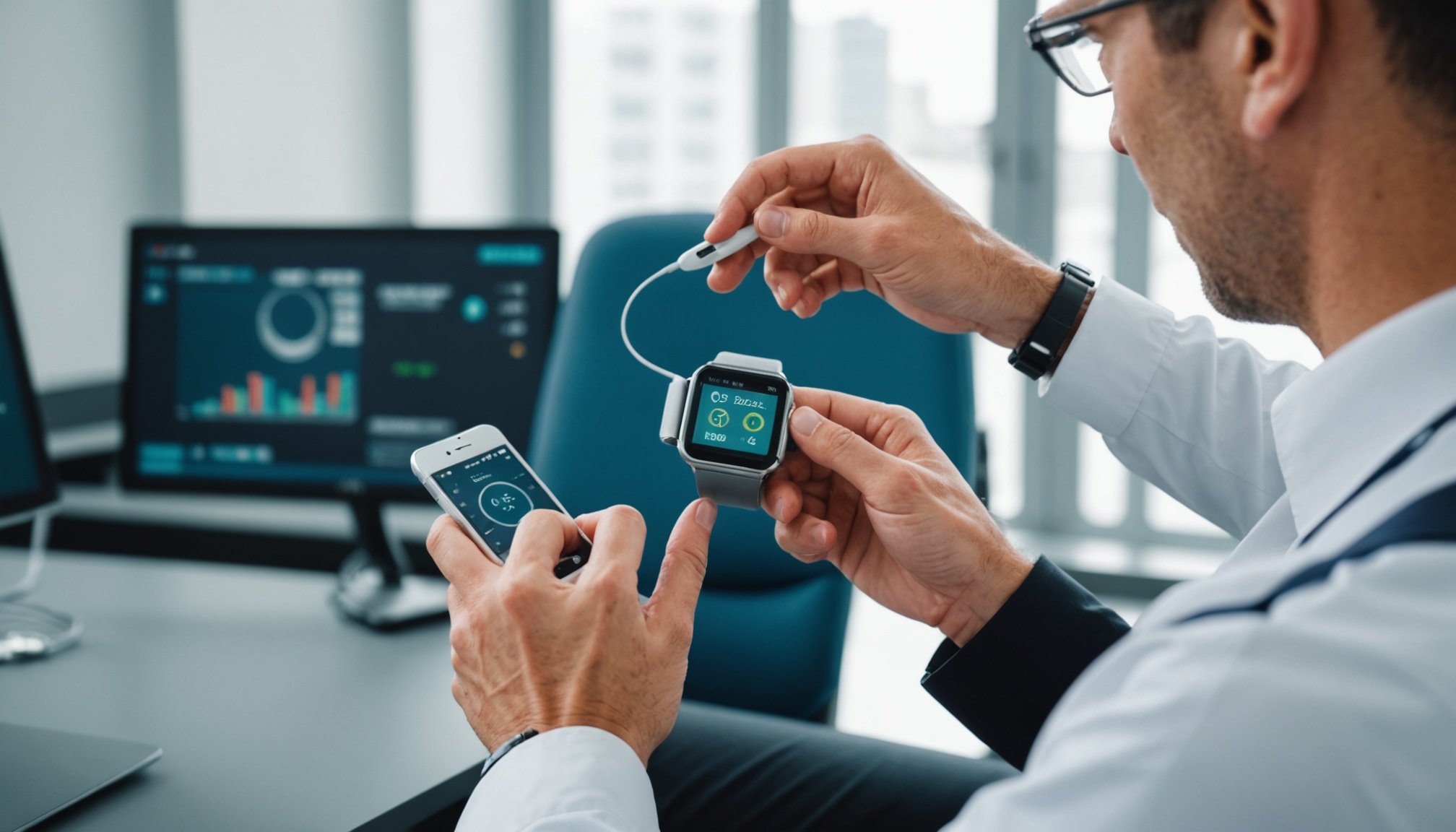Revolutionizing Chronic Disease Care: The Role of Wearable Technology in Monitoring and Management
In the ever-evolving landscape of healthcare, wearable technology has emerged as a game-changer in the management and monitoring of chronic diseases. These innovative devices are not just trendy gadgets but powerful tools that are transforming the way healthcare providers deliver care and how patients manage their health.
The Rise of Wearable Technology in Healthcare
Wearable technology, including smartwatches, fitness trackers, and specialized health monitors, has become increasingly popular over the past decade. These devices are designed to collect a vast array of health data, from heart rate and blood pressure to sleep patterns and physical activity levels.
Also to see : Unlocking Better Mental Health: The Impact of Regular Tai Chi Practice on Seniors
### Key Features of Wearable Health Devices
- **Continuous Monitoring**: Wearables can track vital signs and health metrics in real time, providing continuous data that can be crucial for managing chronic conditions[2][3][4].
- **Personalized Feedback**: Many wearables offer personalized feedback and alerts based on the user's health data, helping individuals make informed decisions about their health[4].
- **Remote Patient Monitoring**: Wearables enable healthcare providers to monitor patients remotely, reducing the need for hospital visits and improving the timeliness of interventions[2][4].
- **User Engagement**: Wearables often include features that encourage user engagement, such as fitness challenges and health education, which can improve adherence to treatment plans[3][4].
Improving Chronic Disease Management
Chronic diseases, such as diabetes, heart disease, and chronic obstructive pulmonary disease (COPD), require ongoing management to prevent complications and improve quality of life. Wearable technology is playing a significant role in this area.
Real-Time Data and Early Intervention
Wearable devices can detect early signs of health deterioration, allowing for prompt interventions. For instance, a study by Philips found that remote monitoring of patients with heart conditions reduced hospital admissions by 30% by enabling early detection and treatment of complications[4].
Also read : Navigating Telehealth: The Benefits and Drawbacks for Chronic Respiratory Disease Management
### Examples of Effective Wearable Technology in Chronic Disease Management
- **Diabetes Management**: Companies like Livongo have developed platforms that combine wearable devices with personalized coaching, resulting in a 20% reduction in glucose levels for users after just three months[4].
- **Heart Disease**: Wearables that monitor heart rate and blood pressure can alert healthcare providers to potential issues, such as atrial fibrillation or hypertension, allowing for timely interventions[2][4].
- **COPD**: Remote monitoring programs using wearable devices can help patients with COPD manage their condition better, reducing the risk of hospital readmissions and improving overall health outcomes[5].
Enhancing Patient Care and Quality of Life
Beyond just monitoring health metrics, wearable technology is enhancing patient care in several ways.
Increased Patient Safety
For elderly individuals living alone, wearable devices can be lifesavers. For example, a fall detection feature can alert emergency services immediately if a person falls, ensuring prompt medical attention[3].
Better Adherence to Treatment Plans
Wearables can remind patients to take their medications and provide feedback on their adherence. The KiLife app, for instance, has shown that 70% of its users report better adherence to their treatment plans due to the app’s reminders and social support features[4].
Improved Physical Activity
Wearables that track physical activity can encourage individuals to stay active. A study found that over 50% of seniors using wearable devices reported increased physical activity, which is crucial for managing chronic conditions[3].
The Role of Healthcare Providers in Leveraging Wearable Technology
Healthcare providers play a critical role in integrating wearable technology into patient care.
Remote Patient Monitoring
Healthcare providers can use wearable devices to monitor patients remotely, receiving real-time data that helps them adjust treatment plans accordingly. Teladoc Health, for example, has seen an 85% improvement in patient health outcomes through its remote monitoring programs[4].
Personalized Care
Wearable technology allows for personalized care plans tailored to individual patient needs. Omada Health’s programs, which include personalized coaching and monitoring, have helped patients reduce their HbA1c levels significantly[4].
Overcoming Challenges and Ensuring Adoption
While wearable technology holds great promise, there are challenges to its widespread adoption.
Privacy and Security Concerns
One of the primary concerns is the security and privacy of the health data collected by wearables. Ensuring that this data is protected and used ethically is crucial for building trust among patients and healthcare providers.
Cost and Accessibility
The cost of wearable devices can be a barrier for some individuals. However, as the technology advances and becomes more mainstream, costs are likely to decrease, making these devices more accessible.
Integration with Existing Healthcare Systems
For wearable technology to be effective, it must integrate seamlessly with existing healthcare systems. For instance, St. Joseph’s Healthcare Hamilton is seeking a solution that integrates with their Epic electronic health record system to support virtual rehabilitation programs[5].
Future Directions and Innovations
The future of wearable technology in healthcare is exciting and filled with potential.
Advanced Analytics and AI
The integration of advanced analytics and AI into wearable devices will enable more sophisticated health monitoring and predictive analytics. This could lead to the early detection of diseases before symptoms appear[3].
Expanded Use Cases
Wearable technology is not limited to chronic disease management. It is being explored for use in mental health, rehabilitation, and even preventive care. For example, Vancouver Coastal Health is looking to implement point-of-care ultrasound devices in long-term care facilities to expedite diagnoses and reduce hospital visits[5].
Practical Insights and Actionable Advice
For individuals considering the use of wearable technology for chronic disease management, here are some practical insights and actionable advice:
### Tips for Using Wearable Technology Effectively
- **Choose Devices That Align with Your Needs**: Select wearables that track the health metrics most relevant to your condition.
- **Engage with Feedback**: Use the feedback and alerts provided by your wearable to make informed decisions about your health.
- **Consult Your Healthcare Provider**: Ensure that your wearable device is part of your overall care plan and discuss the data with your healthcare provider.
- **Stay Connected**: Use social features and community support offered by some wearables to stay motivated and engaged in your health management.
Wearable technology is revolutionizing the way we manage chronic diseases, offering real-time monitoring, personalized feedback, and improved patient care. As this technology continues to evolve, it is essential for healthcare providers, patients, and technology developers to work together to ensure its effective integration into healthcare systems. With the right approach, wearable technology can significantly enhance the quality of life for individuals living with chronic diseases.
### Table: Comparison of Wearable Health Devices
| Device/Platform | Key Features | Benefits | Examples of Use |
|
|--------------|
|-----------------|
| Livongo | Glucose monitoring, personalized coaching | Reduced glucose levels by 20% | Diabetes management[4] |
| Philips | Remote monitoring of vital signs | Reduced hospital admissions by 30% | Heart disease management[4] |
| KiLife | Medication reminders, social support | Improved adherence to treatment plans | COPD and heart disease management[4] |
| Omada Health | Personalized coaching, monitoring | Reduced HbA1c levels by 0.5% to 1% | Diabetes management[4] |
| Teladoc Health | Remote patient monitoring | Improved patient health outcomes by 85% | Chronic disease management[4] |
By embracing wearable technology, we can create a more proactive, personalized, and effective approach to chronic disease care, ultimately improving the health and well-being of individuals around the world.











